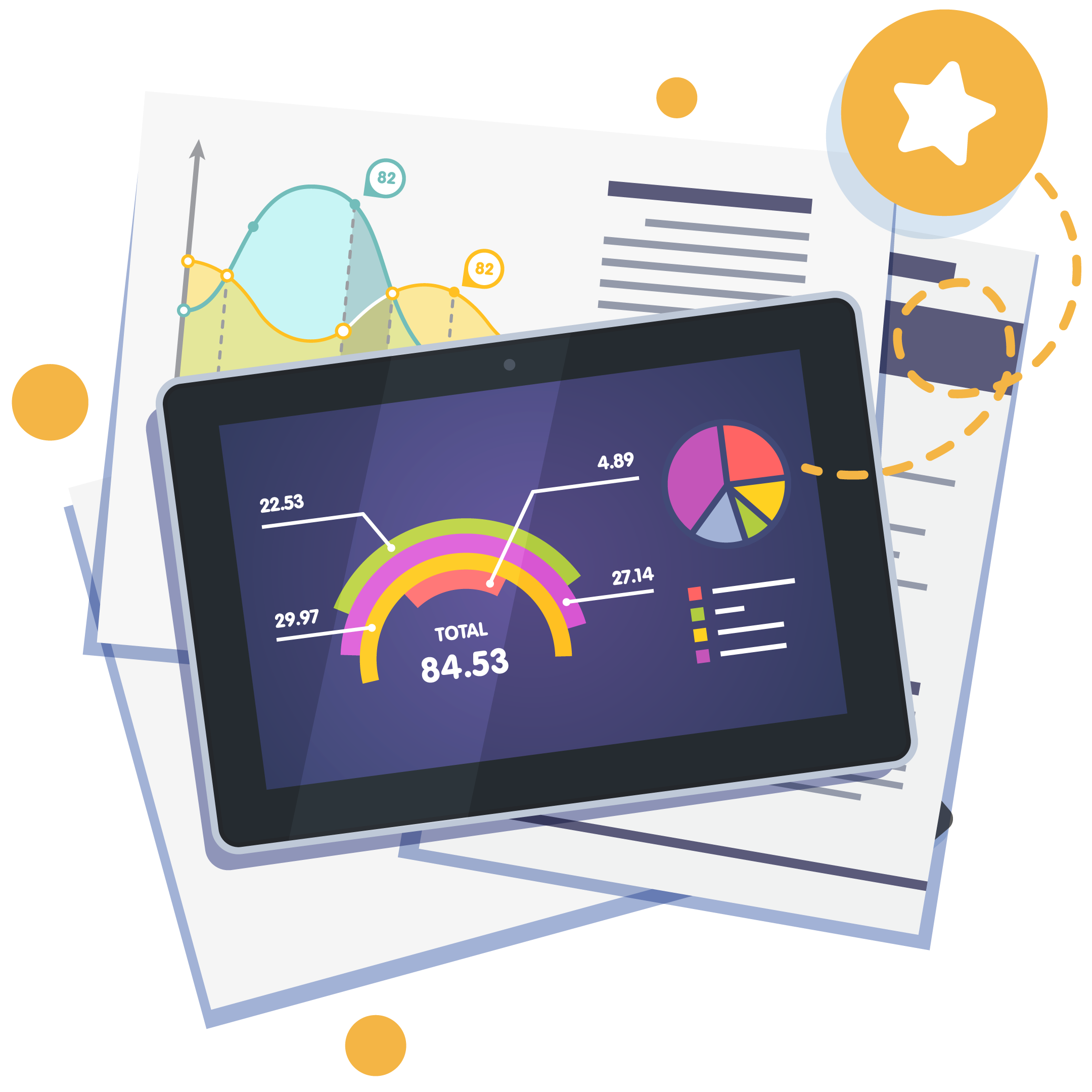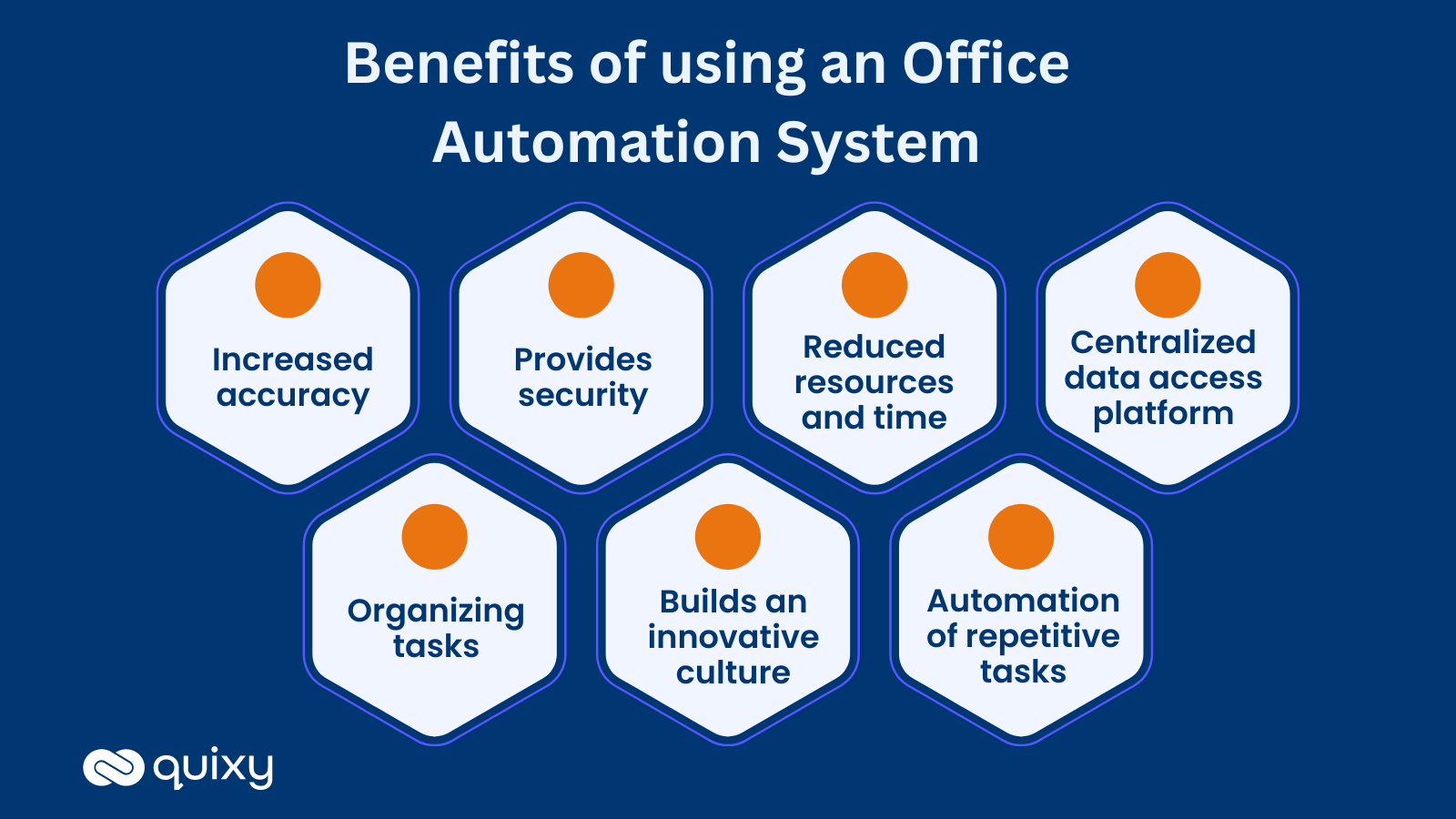
Companies need to adapt to these changes and move to automated systems due to the rapidly changing nature of technological innovations. The benefits of which can not be overlooked.
The day-to-day activities of office administration can be significantly impacted by technology.
Over 80% of organization leaders, according to research, say that they have increased automation and increased their use of remote work.
Office automation systems are, therefore, essential to boosting business productivity and maximizing profits.
Your responsibility as a business leader is to measure what is working and not working inside your office space. Most likely, you already have some office automation tools, but let’s explore what else office automation can do for your company.
What is an Office Automation System?
Office automation systems effectively collect, arrange, store, examines and distribute private data among various systems to process repetitive, routine tasks. Without human intervention, office automation systems enable flawless and error-free data flow.
It categorically helps to simplify office-related tasks while maximizing office productivity. It does this by utilizing hardware and software solutions.
The amount of time employees spend is significantly reduced, allowing them to focus on tasks that require more attention and opening up new opportunities for your company.
Why should you use an Office Automation System?
Office automation systems benefit businesses of all sizes in the current digital era.
Powerful office automation systems store much data in a small space while reducing manual work.
They speed up information retrieval in addition to streamlining daily tasks.
These tools also increase process visibility and make it simple for businesses to identify bottlenecks.
On the other hand, automation might have you going to witness data move about on its own.
Your workflows become more efficient thanks to an integrated office automation system, but you must look beyond emails and online forms to benefit fully. Discover untapped automation opportunities across your departments with an automation report!
Also Read: Supercharge your Productivity with an effective Task Management System

Benefits of Office Automation System
The benefits of implementing office automation for businesses are numerous. These benefits are:

1. Increased accuracy
Errors are made by people, not by properly implemented automated systems.
Human errors can be expensive and inefficient because they require correction and slow productivity.
Adding too many digits, for instance, when paying a vendor or employee. Serious errors may result in security and compliance problems and possible fines and penalties.
Office automation tools reduce human involvement in data transfer, which reduces the likelihood of errors.
2. Provides security
An office automation system has many advantages, including security against internal and external threats and assistance with data backup and recovery options.
The right cloud-based security features will safeguard sensitive information about your company and its employees.
3. Reduced resources and time
Organizations can accomplish more with less by automating processes.
Employees can focus more on high-value tasks by eliminating tedious and time-consuming processes.
For instance, going back to the well-known paperless benefit, employees no longer have to spend as much time gathering the necessary documentation, entering that information, or filing away copious paper copies when using office automation software. The system takes care of it.
In fact, 78% of leaders believe that automation could free up three hours per day for an employee.
4. Centralized data access platform
It aids in developing a centralized platform for cloud-based data access, manipulation, and storage.
By integrating your workplace database, this platform makes it simple and safe for everyone to facilitate quick data exchange.
5. Organizing tasks
Office automation software has many advantages, one of which is its ability to replace time-consuming and tedious tasks with organized ones.
These processes also reduce manual labour so that attention can be focused on tasks of higher value.
6. Building an innovative culture
While manual processes that have never been challenged foster a culture of “good enough” and set up an organization for mediocre performance. Over the long term, exercises that encourage problem-solving generate the right sparks for team members to advance and inevitably serve stakeholders more significantly and effectively.
7. Automation of repetitive tasks
The difference between two organizations, one with a manual process and the other with automated processes, is exponential rather than linear.
An organization with automated processes can perpetually reinvest savings from resources and time towards high-impact projects rather than spending time copying, moving, or manually entering data.
Also Read: A Complete Guide to Workflow Automation Software
What are the essential features of Office Automation Tools?
With plenty of office automation systems available in the market, choosing the right one becomes tricky. However, with the advent of evolving technology, some features have become non-negotiable in an office management tool. Listed below are some essential features:
1. Mobile Access
Gone are the days when you have to stick to your laptop desk for everything; today, we keep convenience in our pockets and call them mobiles. An amazing office automation tool should allow you to access everything at your fingertips so that the work never stops. Advanced workflow tools enable easy mobile accessibility, so you don’t have to worry about not being stuck o your desk.
2. Easy workflow design-builder
Automation and digitization are two different things. Only digitizing processes will not help; only when you automate will you get the right results. Current office automation tools have an in-built workflow design system that enables you to design and create workflows the way you want to.
For example, Quixy’s no-code workflow automation tool allows business users to create applications that aid their work and enhance performance.
3. Integration with other applications
An office automation tool is only helpful when it helps you create a smooth workflow. You are only moving backwards if you cannot integrate the solutions with other apps you use in the office. Office management tools should be integrated with project management tools, customer relationship management systems, accounting software etc.
4. Access control management
The whole idea of access control is to ensure the confidentiality and security of sensitive information. While there are different levels of every workflow, your workflow system should enable you to set and determine information authorisation.
5. Task Management
Task management is an essential part of office automation tools. The user should be able to organize the tasks and should be able to prioritize them. Tracking the progress and collaborating with other team members efficiently is as crucial.
Office Automation Examples
1. Approvals for documents
Automated systems that require office managers’ signatures for sign-off are possible, eliminating administrative staff needs.
2. Detection of security intrusions
Hackers frequently breach office networks, so having an intrusion detection system can help office managers safeguard essential assets.
3. Utility management
When no employees are present, lights and heating can be turned off or reduced thanks to connected devices and the Internet of Things.
4. Managing documents
You can automatically manage compliance, privacy, and data governance rules by installing a software system to handle all the elementary events.
5. Management of customer information
Utilize a system to gather and analyze valuable customer information to aid in marketing, sales, and product development.
6. Data archiving and backup
Set up automated backups and make sure all corporate files are secure, rather than having someone manually copy and paste essential company files.
7. Automation during onboarding
Within a chat or document repository, a chatbot can quickly assist a new team member in finding documents and getting assistance.
Also Read: Top 9 Benefits of Workflow Automation that you can not deny!
Start your journey today!
Organizing office workflows can be the missing piece in your journey of automation. Choosing the right workflow builder to help you automate should be the first step.
Quixy is a workflow builder that will help you automate and organize office tasks like never before. It has unique no-code capabilities that enable you to build your own processes. Ready to transform your business? Get started now and experience the power of automation and app creation, all without the need for coding skills.
Frequently Asked Questions(FAQs)
What is an Office Automation System and Examples?
An office automation system simplifies daily office tasks. Examples include email software, document management tools, and scheduling apps that help with communication and organization.
What are the Types of Office Automation Systems?
Office automation comes in various forms: communication systems (like email), document management (for files), collaboration tools (for teamwork), and administrative systems (for tasks like HR and finance).
What are the Four Types of Automation?
The main types of automation are industrial automation (in manufacturing), business process automation (for repetitive tasks), IT automation (managing IT processes), and office automation (for office tasks).
What are the Five Components of Office Automation?
Office automation typically includes computers, software, communication systems, data storage, and office equipment like printers. These components work together to streamline office tasks.
What is the Purpose of Office Automation?
Office automation aims to make office work more efficient and productive. It helps with tasks like communication, document management, and data processing, saving time and reducing errors.
Subscribe
Login
Please login to comment
0 Comments
Oldest















